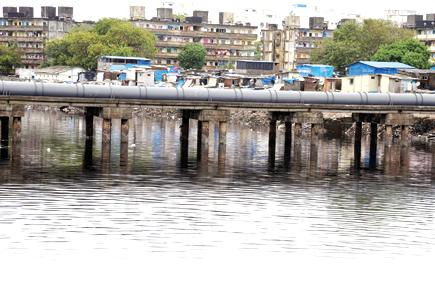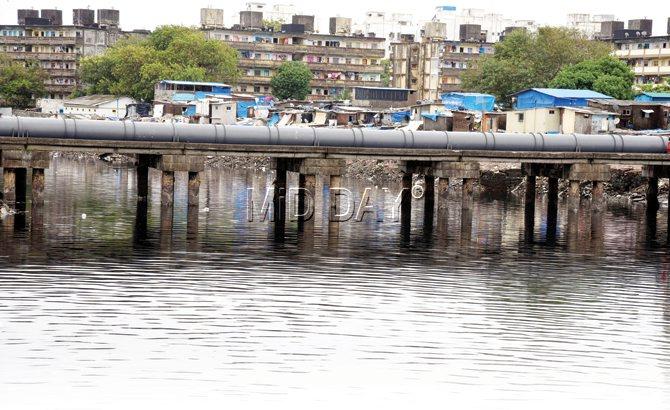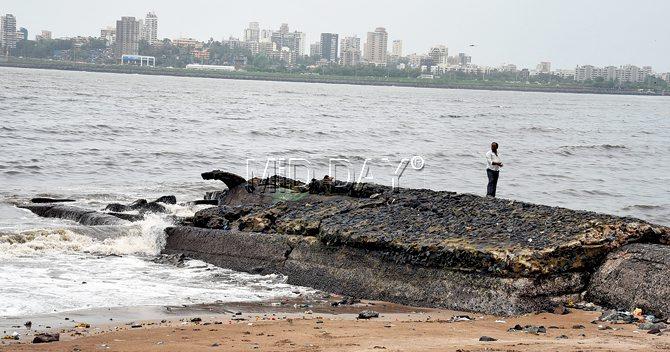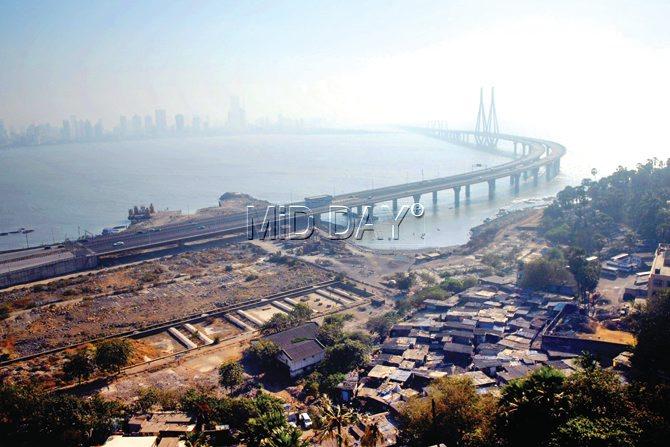The city's western coastline is likely to bear the brunt of untreated sewage; an estimated 2,000 million litres per day (MLD) of untreated sewage is expected to make its way into the sea over the next 10 years

Mahim creek off L J Road, Mahim. Sewage from the Bandra treatment facility passes through this pipe before ending up in the Arabian Sea
Human sewage, which is largely made up of excrement, wastewater and industrial effluents, will continue to impact the city’s ecosystem, and will pose a significant public health threat in the future.
Much like the city’s inland nullahs, rivers and lakes, Mumbai’s coastal waters will become contaminated with pathogenic microbes, resulting in illnesses from waterborne and food-borne pathogens found in the tissues of fish, eventually consumed by humans.
ADVERTISEMENT

Mahim creek off L J Road, Mahim. Sewage from the Bandra treatment facility passes through this pipe before ending up in the Arabian Sea.
This scenario will play out in the future because the city’s western coastline is likely to bear the brunt of untreated sewage; an estimated 2,000 million litres per day (MLD) of untreated sewage is expected to make its way into the sea over the next 10 years. The ecological threat has grown multi-fold over the past decade due to poor planning and shoddy execution of crucial projects meant to augment the existing sewage treatment facilities at Colaba, Worli, Bandra, Versova, Malad, Bhandup and Ghatkopar.

Turf war
Over the past decade, the land reserved for expansion of treatment plants was fought over by state government entities, BMC and the Maharashtra State Road Development Corporation (MSRDC), with parcels of this land allegedly usurped by a private contractor appointed by the development corporation for its infrastructure works.
This fact was highlighted in a 2011 report of former municipal commissioner Subodh Kumar, submitted to the state government, where he revealed that the “apparent intention of the contractor for the Sea Link extension was to use/occupy land meant for a treatment plant for his benefit”.

In a 2011 report, former municipal commissioner Subodh Kumar said that the intention of the contractor for the Sea Link extension was to use/occupy land meant for a treatment plant, for his own benefit. Pic/Pradeep Dhivar
Meanwhile, the approval given to the BMC by the Maharashtra Pollution Control Board (MPCB), allowing the dumping of semi-treated effluents into the sea, expired in 2014. An MPCB notice last year pulled up the corporation for not meeting the set targets of modernising the city’s treatment plants. The MPCB had given its consent to the BMC to discharge sewage into the sea after carrying out preliminary treatment and meeting standards set for effluents, known as SW-2.
Data obtained under RTI by mid-day in July, highlights the threat that looms over marine life on the west coast of Mumbai, along the Arabian Sea. A close look at project files shows that the BMC has bungled the multi-crore Mumbai Sewage Disposal Project (MSDP)-II, meant to augment seven treatment plants along the west coast.
BMC is unlikely to begin the project by 2025, leave alone complete it by then — because MSRDC can’t now hand over the land for the next six years, and the civic body has conceded that the only option left is reclamation. This, 10 years after it planned the R13,500-crore project.
Clearly, the BMC has lost a chance to improve its treatment facilities from the existing preliminary level to either the primary, secondary or even tertiary levels. The conventional sequence of a sewage treatment plant typically goes from primary to secondary to tertiary levels.
To cite an example, primary treatment can reduce biochemical oxygen demand (BOD) by 20 per cent. BOD is the amount of oxygen microorganisms must consume to break down the organic material present in wastewater. This, in turn, increases dissolved oxygen (DO), which is good for aquatic organisms. DO also controls food webs, since living organisms depend on each other for their food needs. The performance of treatment plants is measured in terms of BOD and SS (suspended solid) removals. Most of Mumbai’s plants do not even touch the 20:30 ratio needed for BOD/SS treatment, a mark which qualifies as primary treatment.
The putrid problem has been growing along Mumbai’s coast with regular dumping of partially-treated sewage into the city’s seawater. The BMC maintains that its treatment samples are well within the standard limit, but that is not true.
Some plants may fulfil the standards of dissolved oxygen (DO) and BOD as per SW-2 standards. This is a set of standards, and the mark at which sewage can be released into the sea; the rules also prohibit certain activities provided under coastal regulation zone (CRZ) notification, 2011, set by the MPCB.
The current level of coliform per 100 ml of sewage is 5,000 to 10,000 CFU (coliform forming unit). Coliform are bacteria found in the faeces of man and other warm-blooded animals. The ideal CFU level should be 100 CFU per 100 ml but this is not happening at all seven treatment plants along the city’s west coast: Colaba, Worli, Bandra, Versova, Malad, Bhandup and Ghatkopar.
Waste to the sea
The BMC had been given consent to discharge semi-treated waste into the sea on the condition that it would simultaneously take steps to upgrade its existing infrastructure, including its treatment plants, drain and sewer lines, and phase out old levels of discharging waste by modernising existing plants. Meanwhile, the civic body has not taken any significant steps to improve the collection, conveyance, treatment and disposal of wastewater generated in Mumbai. In a letter written in April 2014, then environment secretary of the state environment department R A Rajeev had clearly warned the BMC that the time for phasing out of existing practices had expired.
Error in judgement
The shoddy planning of implementing MSDP is visible from the fact that the civic body chose a wrong technology that proposes production of a large quantity of sludge after treatment. As a result, the BMC has spent 10 years just to scout for land to dump sludge proposed to be produced from the modernisation of the seven treatment plants.
At Colaba alone, it was estimated that the project flow would increase to 30 MLD by 2016, but the quantity of wet digested sludge expected to be generated was around 20 tonnes daily, or three truckloads per day. The quantity of sludge for the rest of the six plants, which are much bigger in size, would even be more.
“For 10 years all we have done is scout for land to build a centralised sludge dumping and treating facility to effectively handle silt generation from seven new waste water treatment plants,” said a BMC official.
Unanswered questions
RA Rajeev, former additional municipal commissioner at the BMC told mid-day that the choice of technology was made in the late ‘90s and even then a lot of questions had been raised.
“The alternative technology used in smaller civic corporations elsewhere, such as in Thane and Navi Mumbai, does not involve production of sludge. These (plants) are doing really well. But why BMC chose a sludge-based technology, knowing it has no land to dump even the city’s solid waste — forget extra sludge — from the treatment plants, raises a lot of question marks,” he said.
Over the years, several complaints were raised on BMC’s choice of technology but they fell on deaf ears. One such opponent of BMC’s choice was Geeta Kanojia, corporator and former chairman of the ward committee for Colaba. In her letter to BMC five years ago, she pointed to the extreme damage caused to the marine life in her constituency due to untreated sewage being dumped into the sea. She had urged the BMC to choose a better technology, like the one used in Navi Mumbai.
“We have been facing a lot of problems and receiving complaints from fishermen and residents on the existing quality of sewage being dumped in the sea that has severely affected marine life, affecting fishermen’s livelihood,” she wrote in her letter to the municipal commissioner in 2008.
“Navi Mumbai has been able to achieve better treatment with smaller plants, and is now selling the treated water. The BMC must visit these plants and take a call,” she had said in the letter.
The BMC had, while drawing up the first plans for MSDP, opted for the SBR (sequencing batch reactor) technology over the conventional Activated Sludge (AS)-based treatment. SBR produces far greater quantity of sludge compared to the AS treatment. The Thane Municipal Corporation (TMC), for example, is using the AS treatment with great success for a 120-MLD sewage treatment plant at Kopri. “The operation and maintenance cost of this STP is minimum and there is little sludge generation afterwards. Alas, our COD and BOD values are much less than prescribed by MPCB at the same time,” said Aseem Gupta, former TMC commissioner.
No land for sludge
For the past ten years, the BMC has been sparring with other agencies over a parcel of land at Bandra to set up a sludge treatment facility for the Worli, Bandra, and Dharavi plants. However, the corporation has informed the government that the land has been diverted for the benefit of a private developer appointed by the MSRDC. All this is happening while the MSDP-II has been already delayed by a decade and MPCB’s permission to BMC to dump semi-treated waste into the sea expired last year in 2014.
The BMC had acquired
20 hectares (ha) of land along and under the Bandra-Worli Sea link, behind hotel Taj Land’s End at a cost of R20 crore in 1981, but soon part (4.8 ha) of the land was temporarily handed over to MSRDC for construction of the Bandra-Worli Sea Link and about 5.5 ha was given to the Mumbai Maritime Board (MMB) for its water transport project (for construction, and modernisation of its existing jetty along the Bandra-Worli Sea Link).
At some point it was decided the two agencies (MSRDC and MMB) would pay R81 crore in cost and rent to the BMC. In 2003, the government gave directives that the amount would be adjusted from what BMC owed to the irrigation department for lifting of water from the Bhatsa dam. BMC was to pay the PWD department for water; the amount in turn would be paid to the MSRDC. However, neither has any payment been made, nor has any land made available, even as BMC continues to pay
R12.4 lakh every year in NA tax (non-agriculture tax, a set of mandatory taxes levied by the state government on every piece of land which is to be developed in a non-agricultural manner) on the leased land, senior officials said.
The BMC officials in the past ten years have sent 27 notices to the MSRDC, but to no avail. A former BMC commissioner even alleged in his letter to the government that the land was diverted by the MSRDC for the benefit of a private developer. “MSRDC had committed handing back this land by December 2009. But this land was never diverted by MSRDC to the bidders for the Sea Link. Nevertheless, the land was never vacated and it seems the apparent intention of the contractor for the Sea Link extension was to use/occupy land for his benefit,” then civic commissioner Subodh Kumar wrote in a scathing letter to his counterpart in MSRDC on November 2, 2011.
This single piece of land is the reason for delay in construction of the Bandra Worli Sea Link, Worli-Haji Ali and Nariman Point link, MSDP-II, Coastal Road, construction of a Toll Control Plaza, and a jetty. The agencies involved — BMC, MSRDC and MMB — have only traded charges of nepotism and passing on illegal benefits for private use without doing much to solve the problem at hand.
Another decade to go?
Assistant Municipal Commissioner Rajiv Jalota in his letter on August 13, 2014 (report no. DMC/E/1590) told the government and MPCB that expansion work at Bandra cannot start for “at least next six to eight years and untreated sewage will have to be discharged in the sea for next ten years at least”.
“A major policy call needs to be taken on this,” the AMC had warned the government. There are two sides to this dispute: while the BMC blames the then chief minister in 2005 for messing up the issues, who on March 10, 2005 gave orders directing BMC to not charge costs from the other agencies in exchange of land. This was done in the absence of any BMC officials. “This was in violation of Section 92 of the MMC (Mumbai Municipal Corporation) Act that mandates permission of standing committee to lease any land,” an internal BMC report had noted.
The government’s reasoning was that the sea link was a part of the city’s development plan (DP) and therefore BMC must give land free of cost. But a report of then chief engineer in 2005, clearly stated that the “proposed sea link is not part of DP and BMC must not hand it over free as MSRDC will collect toll from it.” Following this, the then commissioner Johny Joseph refused to hand over the plot for free going against the chief minister’s decision.
Allan Grant, project manager for BMC pointed out that it was not advisable to have a toll tower near the treatment plant from the safety point of view. Such close proximity will also lead to respiratory and health problems. “Hydrogen sulphide generated by the wastewater will be released into the atmosphere at the treatment units. This gas, if the building is closer, could damage electronic equipment,” said Grant. The MSRDC did not construct a toll plaza but claimed it was blocking the land for future expansion of the Sea Link.
Then commissioner S S Kshatriya commented: “The BMC is already suffering from a penalty from the MPCB for not treating the sewage to the required SW-2 standards. We cannot afford to let MSRDC have land for the next 4 to 5 years, please hand over our land at the earliest.” Kshatriya made these comments in a letter dated November 25, 2010. He warned: “If the above land is not made available, the BMC cannot treat the sewage from Bandra and Dharavi to the statutory requirement of MPCB. In such a situation, BMC would be liable for failure to achieve these standards and for the degradation of the environment that would result.”
The MSRDC approached the state claiming the BMC’s now modified demand of R200.59 crore with interest for the land cost was ‘absurd’. The MSRDC clearly said the question of paying this amount did not arise. It warned that its public undertaking committee (PUC) had decided if MSRDC was forced to pay up, the burden will be transferred to the commuter by way of toll,” the MSRDC wrote last year to the state government. The BMC claims it is still getting just verbal assurances from the MSRDC.
The only option left with the corporation now to carry out reclamation from the sea, (an area of nearly 30 ha), when the construction of the proposed coastal road starts. But that is unlikely to be any time soon, said officials.
 Subscribe today by clicking the link and stay updated with the latest news!" Click here!
Subscribe today by clicking the link and stay updated with the latest news!" Click here!







